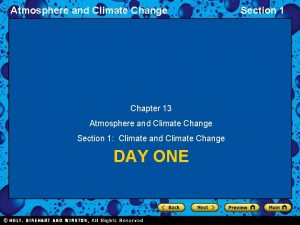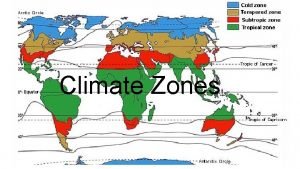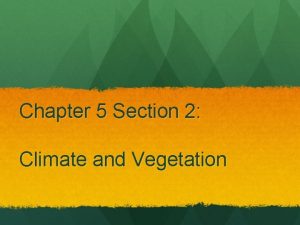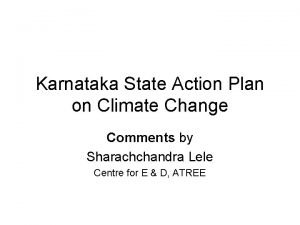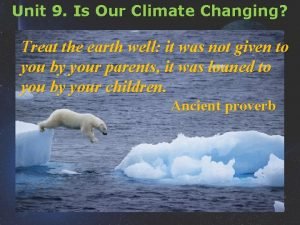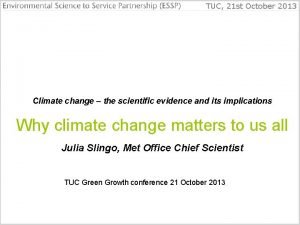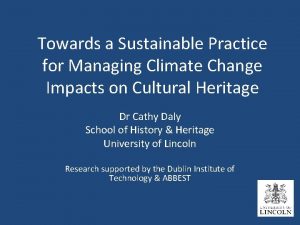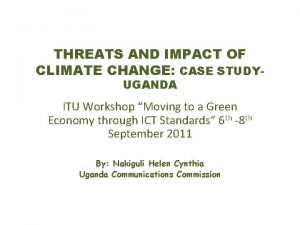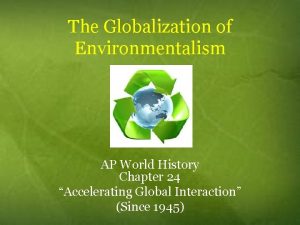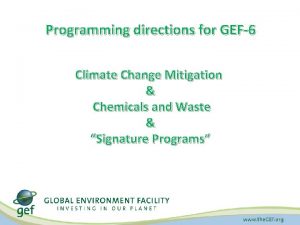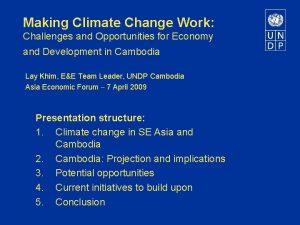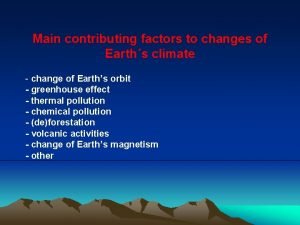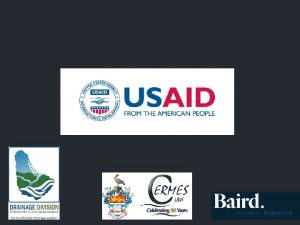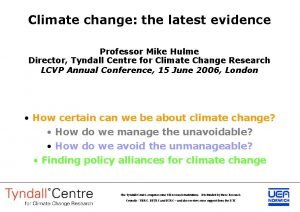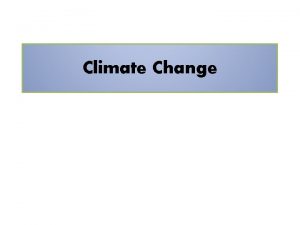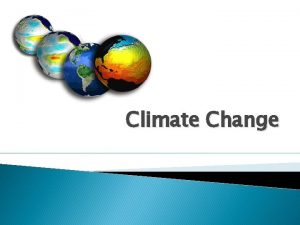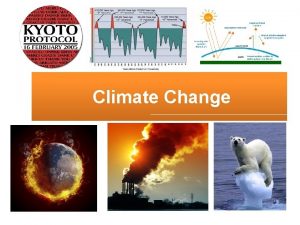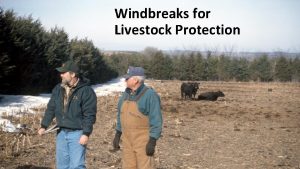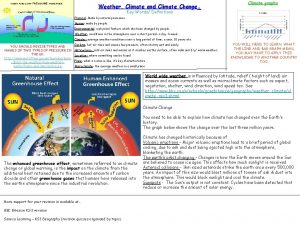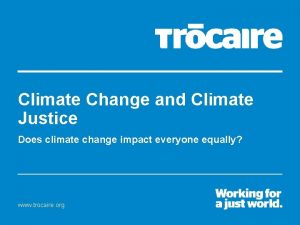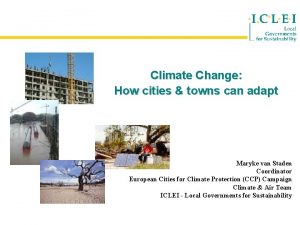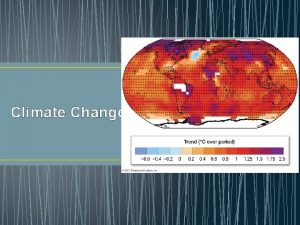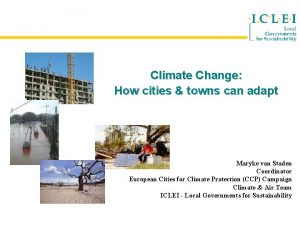Livestock and climate change Livestock makes a key





















- Slides: 21

Livestock and climate change

• Livestock makes a key contribution to global food security. • Its contribution is especially important in marginal lands where livestock represents a unique source of energy, protein and micronutrients. • Climate change has substantial impacts on ecosystems and the natural resources upon which the livestock sector depends. At the same time, livestock food chains are major contributors to greenhouse gas emissions (FAO, 2006). • Livestock production is a rapidly growing sector. It accounts for 40 percent of the global agricultural gross domestic product and is crucial for food security in all regions. • In sub-Saharan Africa, more than half the population keep livestock, and one in three of these livestock keepers can be considered poor

The impact of climate change on livestock production - the need for adaptation • Climate change poses serious threats to livestock production. Increased temperatures, shifts in rainfall distribution, increased frequency of extreme weather events and consequent increased heat stress and reduced water availability are expected to adversely affect livestock production and productivity around the world both directly and indirectly. • The most serious impacts are anticipated in grazing systems because of their dependence on climatic conditions and the natural resource base, and their limited adaptation opportunities • Impacts are expected to be most severe in arid and semi-arid grazing systems at low latitudes, where higher temperatures and lower rainfall are expected to reduce yields on rangelands and increase land degradation (Hoffmann and Vogel, 2008). • The direct impacts of climate change are likely to be more limited in non-grazing systems mostly because the housing of animals in buildings allows for greater control of production conditions (FAO, 2009; Thornton and Gerber, 2010). • Indirect impacts will be experienced through modifications in ecosystems, changes in the yields, quality and type and availability of feed and fodder crops, and greater competition for resources with other sectors (FAO, 2009; Thornton, 2010; Thornton and Gerber, 2010). • Climate change could lead to additional indirect impacts from the increased emergence of livestock diseases, as higher temperatures and changed rainfall patterns can alter the abundance, distribution and transmission of animal pathogens (Baylis and Githeko, 2006). In non-grazing systems, indirect

Direct and indirect impacts of climate change on livestock production systems Grazing systems Direct impacts of climate change increased frequency of extreme weather events Non-grazing systems increased frequency and magnitude of droughts and floods productivity losses resulting from physiological stress due to higher temperatures change in water availability, which may increase or decrease depending on the region Indirect impacts Agro-ecological changes and ecosystem shifts leading of climate change to: alteration in fodder quality and quantity change in water availability, which may increase or decrease depending on the region increased frequency of extreme weather events, with impact being less acute than for extensive systems increased resource prices (e. g. feed, water and energy) change in host-pathogen interaction resulting in disease epidemics an increased incidence of emerging diseases increased cost of animal housing disease epidemics (e. g. cooling systems)

Vulnerability factors to climate shocks • Livestock’s vulnerability to climate shocks depends first on their exposure, which is determined by the duration, frequency and severity of the shocks, and the location of the stocks and related assets (e. g. feedstock, housing, water points). • It also depends on their sensitivity, which is determined by the breed ( for the impact of climate change on animal genetic resources), the housing or feeding system, status of animal health (e. g. vaccination rate) and the importance of livestock to the household in terms of food security and livelihoods (ICEM, 2013). • A number of other factors can increase livestock’s vulnerability to climate change, especially in semi-arid and arid regions. • These factors include rangeland degradation, the fragmentation of grazing areas, changes in land tenure, conflicts and insecure access to land markets (e. g. crop residues and by-products for feed, animal products). • Socio-economic factors that specifically affect disease prevalence include changes in land use, host abundance, international trade, migration and public health policy.

Areas of habitat loss appear in red, areas of no expected change in dark green and areas of habitat gain in light green. Acase of Kenya Kenhan Kamba cattle

Impact of climate change on animal health • Infectious diseases in animals and their transmission cycles represent complex interactions between hosts, pathogens and the environment (Peterson, 2006) and mainly occur following changes in the host-pathogen-environment system (Jones et al. , 2008). • Most of these diseases are zoonotic, i. e. may be transmitted to humans, and can have serious consequences for public health, the economy of the livestock sector and biodiversity conservation (Pinto et al. , 2008). • Climate change, in particular global warming, likely affects animal health by influencing the hostpathogen-environment system both directly and indirectly. • The direct effects are more likely to influence diseases that are associated with vector transmission, water or flood, soil, rodents, or air temperature and humidity (Abdela and Jilo, 2016). • Indirect impacts of climate change are more complex to disentangle and include those deriving from changes in land use and biodiversity and the attempt of animals to adapt to these climatic and environmental changes or from the influence of climate on microbial populations, distribution of vector-borne diseases and host resistance to infectious agents, feed and water scarcity, or food-borne diseases.

Impact of climate change on animal health • In particular, prolonged droughts determine water and pasture shortages, which decrease livestock immunity against infectious diseases, as well as trigger livestock movements to areas at higher risk of animal diseases, determining the congregation of domestic animals around few available watering points and grazing areas in proximity to wildlife reserves. Here the risk of disease transmission is increased by the increased contact among domestic animals and between domestic and wild animals (Pinto et al. , 2008). • Grazing areas resulting from deforestation and changes in land use may expose livestock to novel pathogens due to increased interface between livestock and wildlife (Lubroth, 2012). These direct and indirect effects of climate change may be spatial, i. e. , affecting the geographical distribution of the pathogen, host or vector, or temporal, i. e. , affecting the timing of an outbreak and its intensity (Lubroth, 2012; Abdela and Jilo, 2016). However, not all organisms will respond similarly to climate change. • In general, disease agents with external stages (e. g. , non-host) of their life cycles, such as parasites, food-, water- and vector-borne diseases are most influenced by climatic and environmental changes. For instance, temperature increases feeding intervals and development rates of blood-feeding arthropods, while rainfall increases the availability of habitat for breeding sites. • In general, global warming and changes in rainfall patterns and intensity are expected to expand the geographical and altitudinal distribution of vectors, allowing them to cross mountain ranges that currently limit their distribution (Abdela and Jilo, 2016). Furthermore, climate change can also influence livestock health through the survival of pathogens in the environment. A pathogen may emerge in new territories and host landscapes; become more aggressive, and perform a host-species jump, possibly in relation to increased host species mixing or contacts (Lubroth, 2012).

• Vector-borne diseases that are strongly associated with vector amplification due to climate variability include Rift Valley fever (RVF), West Nile Virus (WNV), Bluetongue (BTV) and Trypanosomosis. For instance, RVF in East Africa is strongly associated with extreme events, such as heavy rains and floods, caused by the El Niño Southern Oscillation events, which are expected to occur more frequently in the future as an effect of global climate change (FAO et al. , 2015). On the contrary, West Nile Virus (WNV), Bluetongue (BTV) and Trypanosomosis appear to be strongly influenced by global warming and raise in temperature (Paz, 2015). • Soil-borne diseases, such as Anthrax, are also affected by precipitation variability. Livestock and wildlife likely get infected with Anthrax while grazing and ingesting forage or soil contaminated with Anthrax spores, browsing on vegetation contaminated by carrion flies, or by percutaneous exposure from biting flies, and possibly spore inhalation (WHO, 2008). Anthrax outbreaks mainly occur after heavy rains and floods followed by a dry period or with the onset of rains ending a period of drought (Blackburn et al. , 2007; Patassi 2016). These climatic conditions favor the concentration of spores in the upper level of the soil, increasing the risk of spore ingestion by herbivores. Climate change can also impact animal health in the Arctic region. • The Anthrax outbreak that affected the reindeer population and humans in the Yamalo-Nenets region of Siberia in July 2016 is suspected to be associated with global warming and the abnormal warm temperatures observed in 2016, which may have substantially reduced the snow cover, water ice and permafrost in the area (FAO, 2017 a). The previous reported outbreak in the area occurred in 1941, about 75 years ago. Time-series analyses of satellite-derived climate data over the past decades suggested that the observed changes in climate and livestock production system in the region may have increased animal exposure to Anthrax infected soil (FAO, 2017). • Disease agents whose transmission depends primarily on close host-to-host contact can also be favored by extreme weather events that may increase contacts between naive and infected populations. For instance, prolonged droughts can increase the risk of occurrence of foot and mouth disease, hemorrhagic fevers, and tuberculosis (Abdela and Jilo, 2016).

• Climate change has already been shown to determine a mismatch between migratory bird nesting and peak food abundance (Both et al. , 2006) as well as changes in migration routes and timing (Hurlbert and Liang, 2012). The scarce availability of food during nesting is a great stressor that increases disease prevalence. At the same time, climate change may reduce available habitats, determining higher congregation of birds of several species in smaller areas of remaining resources and increasing the chance of within-species and cross-species disease transmission. • Changes in migration routes and timing may also favor the emergence and introduction of a pathogen carried by birds in novel areas. This scenario is a likely explanation for the recent spread of highly pathogenic H 5 N 8 avian influenza in Africa (FAO, 2017 b). • Climate variability in rainfall, temperature, humidity patterns and extreme weather events, such as floods, droughts, heatwave, are therefore considered important indicators for monitoring and predicting animal diseases occurrence. As shown by the FAO Emergency Prevention System (EMPRES) since its implementation in 1994, early warning, early detection and early response are key in the prevention and control of both old and new emerging animal diseases (Lubroth, 2012). Using an algorithm developed by NASA and partners, a near-real time early warning system prototype for RVF has been developed using Google Earth Engine to identify and predict areas at risk of RVF vector amplification in East and West Africa (FAO, 2017). • Therefore • Preventive veterinary medicine, together with adjustment of animal husbandry and social resilience represents a way of coping with the negative consequences of climate change

Livestock production impact on climate change - need for mitigation of climate change • The livestock sector is a major contributor to climate change, generating significant emissions of carbon dioxide (CO 2), methane and nitrous oxide. • Livestock contribute to climate change by emitting greenhouse gases either directly (e. g. from enteric fermentation and manure management) or indirectly (e. g. from feed-production activities, the conversion of forest into pasture). Based on a life cycle assessment of the livestock sector, FAO estimates that it emits about 8. 3 gigatonnes of CO 2 equivalent (CO 2 eq. ), distributed as follows.

• Land use and land-use change accounts for 0. 7 gigatonnes of CO 2 eq. per year (9 percent of the sector’s emissions). This figure refers to the carbon dioxide emitted from the replacement of forest and other natural vegetation by pasture and feed crops in Latin America and Soil Organic Carbon release (mineralization) from soils, such as pasture and arable land dedicated to feed production • Feed production releases 2. 6 gigatonnes CO 2 eq. per year (33 percent of the sector’s emissions). It includes carbon dioxide emissions from fossil fuels used in manufacturing chemical fertilizer and pesticides for feed crops, and nitrous dioxide emissions from chemical fertilizer application on feed crops (grasses and legumes. It does not include the carbon released by field operations (Soil Organic Carbon mineralization). • livestock production releases 3. 7 gigatonnes CO 2 eq. per year (46 percent of the sector’s emissions), including from: enteric fermentation from ruminants (as methane) and on-farm fossil fuel use (in the form of carbon dioxide). • Manure management (mainly manure storage, application and deposition) accounts for 0. 8 gigatonnes CO 2 eq. per year (10 percent of the sector’s emissions) from methane and nitrous oxide. • Processing and international transport produces 0. 23 gigatonnes CO 2 eq. per year (3 percent of the sector’s emissions). • There are striking differences in global emission intensities among commodities. For example, on a global scale, the emission intensityvii of meat and milk, measured by output weight, corresponds on average to 46. 8 kg CO 2 eq. per kg of carcass weight for beef; 72 kg CO 2 eq. per kg of carcass weight for pork; 5. 1 kg CO 2 eq. per kg of carcass weight for chicken; and 2. 9 kg CO 2 eq. per kg of milk (FAO, 2013).

Farming insects as 'minilivestock' • The majority of insect collection occurs through wild gathering, mainly in forests. The concept of farming insects for food or feed is relatively new. • Farming insects as “minilivestock” offers great opportunities to provide food at low environmental cost, without compromising wild insect populations and contributing positively to livelihoods in the context of climate change thanks to their high feed-conversion efficiency, relatively low greenhouse gas and ammonia emissions, and lower water requirements than cattle rearing. An example of rearing insects for human consumption in the tropics is cricket farming in the Lao People’s Democratic Republic, Thailand Viet Nam. • Insects can supplement traditional feed sources, such as soy, maize, grains and fishmeal, to meet the increasing compound demand for feed production worldwide. Insects with the largest immediate potential for large-scale feed production are larvae of the black soldier fly, the common housefly and the yellow mealworm -but other insect species are also being investigated for this purpose. Producers in China, South Africa, Spain and the United States are already rearing large quantities of flies for aquaculture and poultry feed by bioconverting organic waste.

Climate-smart livestock production strategies • Resource use efficiency • Given the current and projected scarcity of resources and the anticipated increase in demand for livestock products, there is considerable agreement that increasing efficiency in resource use is a key component to improving the sector’s environmental sustainability. • More efficient use of natural resources is a crucial strategy for decoupling growth in the livestock sector from its adverse environmental impacts. Efficiency in the use of natural resources is measured by the ratio between the use of natural resources as input to the production activities and the output from production (e. g. kg of phosphorus used per unit of meat produced, or hectares of land mobilized per unit of milk produced). The concept can be extended to the amount of emissions generated by unit of output (e. g. greenhouse gas emissions per unit of eggs). Examples of opportunities that fall within this strategy are higher yields per hectare, higher water productivity, higher feed efficiency, improved management of manure and fertilizers and reduced losses along the food chain (Westhoek et al. , 2011). Efficiency gains in the uses of resources can be achieved through improvements in management, technology, animal health, livestock breeds and feed crop varieties. • Improving the feed-to-food conversion efficiency in animal production systems is a fundamental strategy for improving the environmental sustainability of the sector. A large volume of food is wasted even before it reaches the consumer. FAO (2011 a) suggests that about one-third of all food produced for human consumption is wasted. Along the animal food chain, reduction of waste can substantially contribute to lowering the demand for resources, such as land, water, energy, as well as other inputs, such as nutrients. • The current prices of inputs (e. g. land, water and feed) used in livestock production often do not reflect true scarcities. Consequently, input costs do not provide disincentives for the overutilization of resources by the sector nor incentives to address inefficiencies in production processes. Any future policies to protect the environment will have to introduce adequate market pricing for natural resources. Ensuring effective management rules and liability, under private or communal ownership of the resources, is a further necessary policy element for improving the use of resources.

Climate-smart livestock production systems in practice • Land-based systems • Several climate-smart options are available for land-based systems (i. e. systems depending mainly on grazing). • They include reductions in enteric methane emissions through improved feed digestibility and carbon dioxide removals through soil carbon sequestration. The applicability of these options to low-input systems with infrequent human intervention tends to be quite limited because they require a high level of management. • Manure management mitigation options have a high potential in landless systems but a much more limited potential in land-based systems. Climate-smart options deemed suitable for land-based systems, along with their effectiveness to satisfy multiple climate-smart objectives. • •

Climate smart practices Impact on food Effectiveness of climate Main constraints to adoption security climate change mitigation practices adaptation practices and technologies Grazing management +/- Pasture management + Animal breeding + Animal and management herd + Animal health disease and ++ Supplementary feeding + + ++ lack of technical information and capacities, especially in extensive systems ++ technical and economic in extensive systems ++ ++ technical, economic, institutional: especially in developing countries ++ + technical, institutional: especially in developing countries + ++ easy to implement, but costly + not immediately available, may have low acceptability in some countries Vaccines against rumen ++ archaea Warning systems ++ Weather-indexed insurance Agroforestry practices ++ + technical, institutional: especially in developing countries + technical, economic, institutional: especially in developing countries ++ ++ technical and economic

Grazing management • Grazing can be optimized by finding the right balance among the different users of the land adapting grazing practices accordingly. Optimal grazing leads to improved grasslandx productivity and delivers adaptation and mitigation benefits. However, the net influence of optimal grazing is variable and highly dependent on baseline grazing practices, plant species, soils and climatic conditions (Smith et al. , 2008). • One of the main strategies for increasing the efficiency of grazing management is through rotational grazing, in which the frequency and timing of grazing is adjusted to match the livestock’s needs with the availability of pasture resources. Through targeted temporal grazing exclusions, rotational grazing allows for the maintenance of forages at a relatively earlier growth stage. • This enhances the quality and digestibility of the forage, improves the productivity of the system and reduces methane emissions per unit of live weight gain (Eagle et al. , 2012). Rotational grazing is more suited to manage pasture systems, where the investment costs for fencing and watering points, additional labour and management that is more intensive are more likely to be recouped.

Pasture management and nutrition • Pasture management measures involve the sowing of improved varieties of pasture, typically replacing native grasses with higher yielding and more digestible forages, including perennial fodders, pastures and legumes (Bentley et al. , 2008). For example, in tropical grazing systems, substantial improvements in soil carbon storage and farm productivity, as well as reductions in enteric emission intensities, are possible by replacing natural vegetation with deep-rooted pasture species, such as Brachiaria (Thornton and Herrero, 2010). However, there are far fewer opportunities for sowing improved pastures in arid and semi-arid grazing systems. • The intensification of pasture production though fertilization, cutting regimes and irrigation practices may also enhance productivity, soil organic carbon, pasture quality and animal performance (e. g. milk or meat yield). These approaches however, may not always reduce greenhouse gas emissions. Improving pasture quality through nitrogen fertilization may involve trade-offs between lower methane emissions and higher nitrous oxide emissions (Bannink et al. , 2010). In addition, after accounting for energy-related emissions and nitrous oxide emissions associated with irrigation, the net greenhouse gas emissions of this practice may be negative on grazing lands (Eagle et al. , 2012). • Grass quality can also be improved by chemical treatments (e. g. the use of ammonia) and/or mechanical actions (e. g. chopping, grinding, and ensiling). Both synergies and trade-offs can exist between pasture management and biodiversity conservation. Biodiversity conservation can be a constraint to pasture intensification, as fertilization, sowing, irrigation and high stocking rates usually lead to grasslands that have fewer plant species and provide less resources (food, habitat) for animals, and are consequently less rich in biodiversity (Vickery et al. , 2001; Kleijn et al. , 2009).

Animal breeding • Animal genetic resources, breeding more productive animals is a strategy to enhance productivity and thereby lower methane emission intensities. Research has started on the mitigation benefits of using residual feed intake as a selection tool for low methane-emitting animals, but findings have been inconclusive (Waghorn and Hegarty, 2011). • Crossbreeding can deliver simultaneous adaptation, food security and mitigation benefits. For example, composite cattle breeds developed in tropical grasslands have demonstrated greater heat tolerance and disease resistance, and better fitness and reproductive traits compared with pure shorthorn breeds that had previously dominated these harsh regions (Bentley et al. , 2008). • In general, crossbreeding strategies that make use of locally adapted breeds, which are not only tolerant to heat and poor nutrition, but also to parasites and diseases (Hoffmann, 2008), may become more common with climate change. • Adaptation to climate change can also be fostered by switching livestock species such as adopting camels as part of their livelihood strategy.

• Animal and herd management, disease control and feeding strategies • As with all livestock production systems, there a number of animal and herd management options for land-based systems that can enhance animal productivity, improve feed conversion efficiency and thereby reduce enteric emission intensities. • Improving animal husbandry through activities that ensure proper nutrition and appropriate feeding and reproductive strategies, regularly maintaining animal health and using antibiotics responsibly can improve reproduction rates, reduce mortality and lower the slaughter age. All of these measures will increase the amount of output produced for a given level of emissions. The impacts of these measures on adaptation are likely to be neutral. • Breeding more disease resilient animals is one approach to addressing this issue. • Vaccines against rumen archaea • Because of their wide applicability, even for very low-input extensive systems with little human intervention, vaccines against microorganisms that produce methane as a metabolic by-product in low-oxygen conditions (methanogens) in the rumen are a potentially useful mitigation option for ruminants in land-based grazing systems. H • owever, more research and development is needed before this option is ready for widespread adoption (Wright and Klieve, 2011).

• Early warning systems and insurance • The use of weather information to assist rural communities in managing the risks associated with rainfall variability is a potentially effective preventative option for climate change adaptation. It is applicable to all systems, particularly land-based systems that depend heavily on local feed availability and are more vulnerable to production failures. However, there are issues related to the effectiveness of climate forecasts for livestock management that need to be addressed (Hellmuth et al. , 2007). • Weather-indexed Livestock insurance schemes in which policyholders are paid in response to 'trigger events', such as abnormal rainfall or high local animal mortality rates, may be effective when preventative measures fail (Skees and Enkh-Amgala, 2002). There may be limits, however, to what private insurance markets can do for large vulnerable populations facing risks linked to climate change (UNDP, 2008). In situations where risks are unacceptably high for the private sector, public-private partnership approaches to index-based livestock insurance, in which the public sector underwrites a share of these risks, could play an important role.
 Climate change 2014 mitigation of climate change
Climate change 2014 mitigation of climate change Climate change meaning and definition
Climate change meaning and definition Atmosphere
Atmosphere Chapter 13 atmosphere and climate change
Chapter 13 atmosphere and climate change Climate zones and weather worksheet answer key
Climate zones and weather worksheet answer key Chapter 5 section 2
Chapter 5 section 2 Climate change paragraph
Climate change paragraph Karnataka state action plan on climate change
Karnataka state action plan on climate change Brainpop climate types
Brainpop climate types Unit 9 climate change
Unit 9 climate change Conclusion of climate change
Conclusion of climate change Conclusion of climate change
Conclusion of climate change Conclusion of climate change
Conclusion of climate change Mathematics of climate change
Mathematics of climate change Globalization ap world history definition
Globalization ap world history definition Climate change mitigation
Climate change mitigation Pc 414
Pc 414 Conclusion of climate change
Conclusion of climate change Factors of climate change
Factors of climate change Human causes of climate change
Human causes of climate change Conceptual framework maker
Conceptual framework maker Uk climate change
Uk climate change



